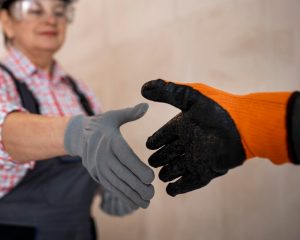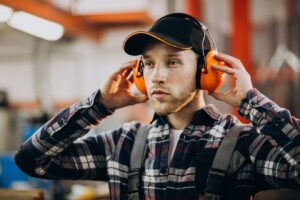
Hearing is one of our most valuable senses, yet it is often taken for granted—until it starts to deteriorate. Millions of workers worldwide are exposed to hazardous noise levels daily, making hearing protection a crucial component of workplace safety. Whether in construction, manufacturing, aviation, or even music and entertainment industries, proper hearing protection can prevent irreversible damage.
But how does hearing protection PPE (Personal Protective Equipment) actually work? And why is it so important? In this article, we’ll explore the science behind hearing loss, the mechanics of hearing protection, and how PPE effectively safeguards our ears from damage.
Table of Contents
Understanding Noise-Induced Hearing Loss (NIHL)
Noise-Induced Hearing Loss (NIHL) is a permanent condition caused by prolonged or sudden exposure to loud sounds. Unlike temporary hearing issues, NIHL is irreversible because it damages the tiny hair cells in the inner ear that are responsible for transmitting sound signals to the brain.
How Loud is Too Loud?
Sound is measured in decibels (dB), and prolonged exposure to sounds above 85 dB can lead to hearing damage. To put this into perspective:
- 30 dB – Whisper
- 60 dB – Normal conversation
- 85 dB – Beginning of potential hearing damage
- 100 dB – Chainsaw, jackhammer (15 minutes exposure can cause harm)
- 120 dB – Rock concert, ambulance siren (immediate damage possible)
- 140+ dB – Gunshot, jet engine (pain threshold, instant hearing loss risk)
The higher the decibel level, the shorter the exposure time needed to cause damage. Without hearing protection, workers in high-noise environments are at serious risk of long-term hearing impairment.
How Hearing Protection PPE Works
Hearing protection PPE is designed to reduce the intensity of incoming sound waves before they reach the inner ear, minimizing the risk of hearing loss. The main types of hearing protection include earplugs, earmuffs, and custom-fitted hearing protectors.
1. Earplugs: The Small but Powerful Protectors
Earplugs are small, insertable devices that block the ear canal to reduce noise exposure. They work by forming a tight seal in the ear, reducing the amount of sound that enters.
Types of Earplugs
- Foam Earplugs – Made of soft, compressible foam that expands to fit the ear canal. Provides excellent noise reduction (up to 33 dB NRR).
- Silicone Earplugs – Moldable and reusable, these offer a comfortable fit and are great for extended wear.
- Flanged Earplugs – Have multiple layers for a snug fit and improved sound blocking.
- Electronic Earplugs – Filter out dangerous noise levels while allowing speech and important sounds to be heard.
Earplugs are lightweight, inexpensive, and effective, making them a popular choice for workers exposed to high-noise environments.
2. Earmuffs: Over-the-Ear Protection
Earmuffs consist of padded ear cups that completely cover the ears, reducing the transmission of sound. They provide a physical barrier that absorbs and dampens noise before it reaches the eardrum.
Types of Earmuffs
- Standard Earmuffs – Passive protection that blocks out sound through thick cushioning and insulation.
- Electronic Earmuffs – Contain built-in microphones and speakers that amplify safe sounds (like conversations) while blocking hazardous noise.
- Helmet-Attachable Earmuffs – Designed to fit over hard hats or helmets for industrial use.
Earmuffs are easy to wear, reusable, and provide consistent protection, making them ideal for workers in environments with fluctuating noise levels.
3. Custom-Molded Hearing Protection
For maximum comfort and fit, some workers opt for custom-molded earplugs or earmuffs. These are made from impressions of the individual’s ear, offering superior sealing and noise reduction. Custom PPE is particularly useful for musicians, pilots, and industrial workers who need long-term, comfortable hearing protection.
How PPE Lowers Noise Exposure: The Science Explained
Hearing protection PPE works by reducing the intensity of sound waves before they reach the sensitive structures of the inner ear. The effectiveness of hearing protection is measured using the Noise Reduction Rating (NRR), which indicates the level of noise reduction provided by the device.
Noise Reduction Rating (NRR) Explained
The NRR is expressed in decibels (dB) and represents the maximum noise reduction achieved under optimal conditions. However, in real-world use, the actual protection is often lower due to improper fit or wear.
NRR Example Calculation:
If a worker is exposed to 100 dB of noise and wears earmuffs with an NRR of 30 dB, the estimated exposure would be:
100 dB – (30 dB ÷ 2) = 85 dB
Since OSHA (Occupational Safety and Health Administration) recommends a derating method, the true noise exposure is reduced by about half the NRR value. This means even high-rated PPE must be properly fitted and worn consistently to be effective.
The Importance of Proper Fit and Usage
Even the best hearing protection is useless if not worn correctly. Studies show that many workers receive only half the expected noise reduction because of improper usage.
Tips for Maximizing Hearing Protection:
- Ensure a Proper Fit – Earplugs should be fully inserted into the ear canal, and earmuffs should create a complete seal around the ears.
- Use the Right PPE for the Job – Choose earplugs or earmuffs with a suitable NRR for the environment.
- Avoid Over-Reliance on PPE – Whenever possible, combine hearing protection with engineering controls (e.g., noise barriers, machine enclosures).
- Maintain & Replace PPE Regularly – Foam earplugs degrade over time, and earmuff cushions can lose their sealing effectiveness.
A combination of earplugs and earmuffs (double protection) is recommended for extreme noise exposure (e.g., airports, gun ranges, construction sites).
Beyond PPE: Additional Ways to Protect Hearing
While hearing protection PPE is essential, other strategies can further reduce the risk of hearing loss.
1. Engineering Controls
- Installing soundproof barriers to block noise.
- Using quieter equipment or retrofitting existing machines with noise-reduction features.
- Implementing distance strategies, such as keeping noisy machines away from workers.
2. Administrative Controls
- Rotating workers to limit exposure time in noisy environments.
- Enforcing quiet hours to reduce overall noise pollution.
- Providing regular hearing tests to monitor changes in hearing ability.
3. Education & Awareness
- Workers must be trained on:
- The risks of noise exposure
- Proper use of hearing protection PPE
- How to recognize early signs of hearing loss
Hearing conservation programs are mandatory in many industries to ensure long-term hearing health.
Final Thoughts: Prioritize Your Hearing Health
Hearing loss is permanent, preventable, and often overlooked until it’s too late. The science behind hearing protection PPE is clear—it effectively reduces noise exposure and safeguards your ears from damage. By choosing the right PPE, using it properly, and combining it with noise-reduction strategies, workers can preserve their hearing for a lifetime.
If you work in a high-noise environment, make hearing protection a priority today. Your future self will thank you!



